check engine SAAB 9-3 2007 Owner's Manual
[x] Cancel search | Manufacturer: SAAB, Model Year: 2007, Model line: 9-3, Model: SAAB 9-3 2007Pages: 304, PDF Size: 26.16 MB
Page 203 of 304
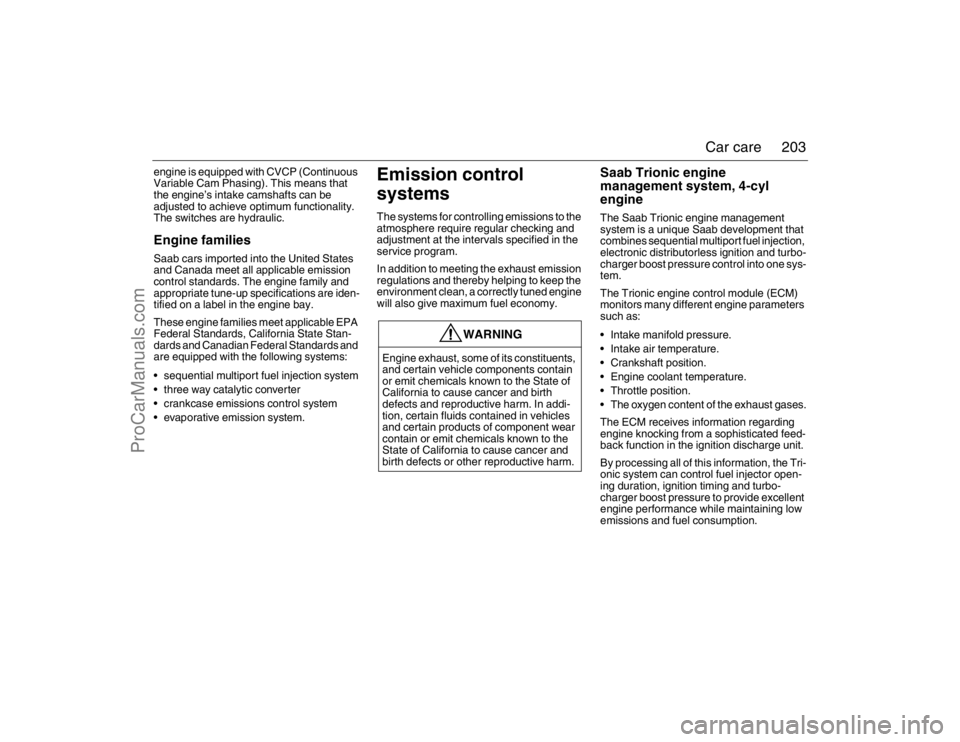
203 Car care
engine is equipped with CVCP (Continuous
Variable Cam Phasing). This means that
the engine’s intake camshafts can be
adjusted to achieve optimum functionality.
The switches are hydraulic.Engine familiesSaab cars imported into the United States
and Canada meet all applicable emission
control standards. The engine family and
appropriate tune-up specifications are iden-
tified on a label in the engine bay.
These engine families meet applicable EPA
Federal Standards, California State Stan-
dards and Canadian Federal Standards and
are equipped with the following systems:
sequential multiport fuel injection system
three way catalytic converter
crankcase emissions control system
evaporative emission system.
Emission control
systemsThe systems for controlling emissions to the
atmosphere require regular checking and
adjustment at the intervals specified in the
service program.
In addition to meeting the exhaust emission
regulations and thereby helping to keep the
environment clean, a correctly tuned engine
will also give maximum fuel economy.
Saab Trionic engine
management system, 4-cyl
engineThe Saab Trionic engine management
system is a unique Saab development that
combines sequential multiport fuel injection,
electronic distributorless ignition and turbo-
charger boost pressure control into one sys-
tem.
The Trionic engine control module (ECM)
monitors many different engine parameters
such as:
Intake manifold pressure.
Intake air temperature.
Crankshaft position.
Engine coolant temperature.
Throttle position.
The oxygen content of the exhaust gases.
The ECM receives information regarding
engine knocking from a sophisticated feed-
back function in the ignition discharge unit.
By processing all of this information, the Tri-
onic system can control fuel injector open-
ing duration, ignition timing and turbo-
charger boost pressure to provide excellent
engine performance while maintaining low
emissions and fuel consumption.
WARNING
Engine exhaust, some of its constituents,
and certain vehicle components contain
or emit chemicals known to the State of
California to cause cancer and birth
defects and reproductive harm. In addi-
tion, certain fluids contained in vehicles
and certain products of component wear
contain or emit chemicals known to the
State of California to cause cancer and
birth defects or other reproductive harm.
93_U S _M 07.book Page 203 W ednesday, April 12, 2006 9:30 AM
ProCarManuals.com
Page 204 of 304

204 Car careBosch ME9 engine management
system, V6 engineThe Bosch ME9 engine management
system is a system that combines sequen-
tial multiport fuel injection, electronic distrib-
utorless ignition and turbocharger boost
pressure control into one system and intake
camshaft phasing control.
The ME9 engine control module (ECM)
monitors many different engine parameters
such as:
Charge air pressure.
Intake air temperature.
Crankshaft position.
Engine coolant temperature.
Throttle position.
The oxygen content of the exhaust gases.By processing all of this information, the
ME9 system can control fuel injector open-
ing duration, ignition timing, intake camshaft
phasing and turbocharger boost pressure to
provide excellent engine performance while
maintaining low emissions and fuel con-
sumption.
ORVR (Onboard Refueling Vapor
Recovery)All hydrocarbons formed when refueling will
be recovered by the car and not released
into the atmosphere. The hydrocarbons are
absorbed in an evaporative emission canis-
ter. When the engine is subsequently
started, the evaporative emission canister is
gradually purged as air is sucked into it
through a shut-off valve. The hydrocar-
bon/air mixture passes through the evap
canister purge valve and into the engine
where it is burned. “Refueling”, see
page 157.
When refueling, make sure you screw the
filler cap on and keep turning until it has
clicked 3 times.
NOTICEThe Trionic engine management system
continuously monitors the operation of
these systems and has on-board diag-
nostic capabilities (OBD II). If the Engine
malfunction (CHECK ENGINE) light in
the main instrument illuminates, the
Trionic ECM has detected a problem. The
car will continue to operate, but perfor-
mance may be diminished. You should
have your car checked by a workshop as
soon as possible. We recommend that
you contact a Saab dealer.
NOTICEThe ME9 engine management system
continuously monitors the operation of
these systems and has on-board diag-
nostic capabilities (OBD II). If the Engine
malfunction (CHECK ENGINE) light in
the main instrument illuminates, the ME9
ECM has detected a problem. The car will
continue to operate, but performance
may be diminished. You should have your
car checked by a workshop as soon as
possible. We recommend that you
contact a Saab dealer.
93_U S _M 07.book Page 204 W ednesday, April 12, 2006 9:30 AM
ProCarManuals.com
Page 207 of 304
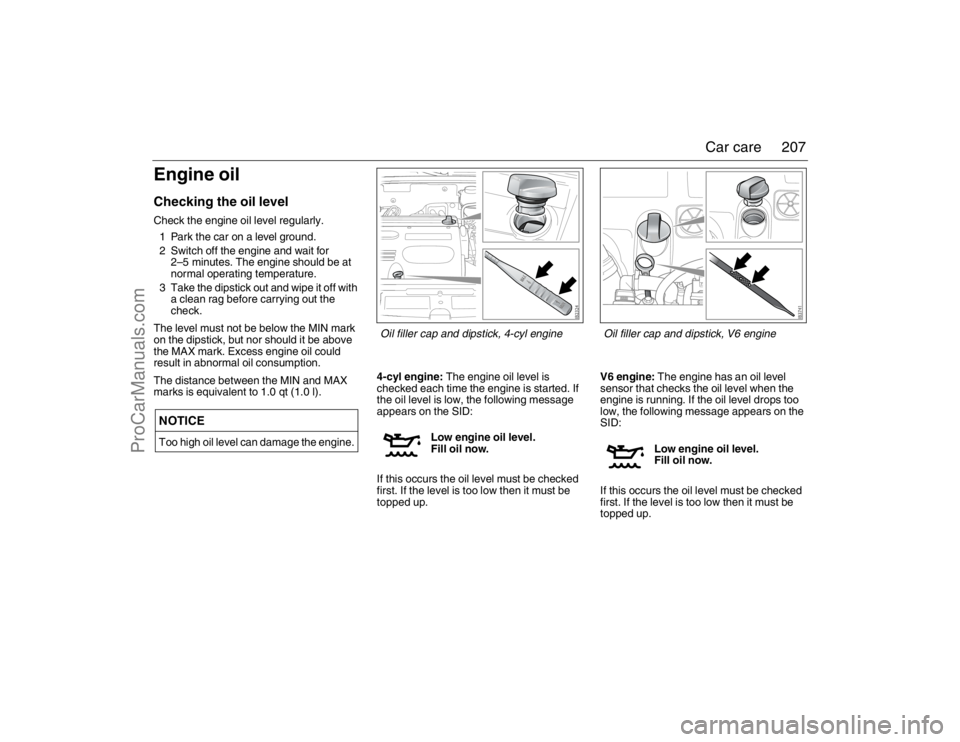
207 Car care
Engine oilChecking the oil levelCheck the engine oil level regularly.
1 Park the car on a level ground.
2 Switch off the engine and wait for
2–5 minutes. The engine should be at
normal operating temperature.
3 Take the dipstick out and wipe it off with
a clean rag before carrying out the
check.
The level must not be below the MIN mark
on the dipstick, but nor should it be above
the MAX mark. Excess engine oil could
result in abnormal oil consumption.
The distance between the MIN and MAX
marks is equivalent to 1.0 qt (1.0 l).4-cyl engine: The engine oil level is
checked each time the engine is started. If
the oil level is low, the following message
appears on the SID:
If this occurs the oil level must be checked
first. If the level is too low then it must be
topped up.V6 engine: The engine has an oil level
sensor that checks the oil level when the
engine is running. If the oil level drops too
low, the following message appears on the
SID:
If this occurs the oil level must be checked
first. If the level is too low then it must be
topped up.NOTICEToo high oil level can damage the engine.
Low engine oil level.
Fill oil now.
Low engine oil level.
Fill oil now.
Oil filler cap and dipstick, 4-cyl engine
Oil filler cap and dipstick, V6 engine
93_U S _M 07.book Page 207 W ednesday, April 12, 2006 9:30 AM
ProCarManuals.com
Page 208 of 304
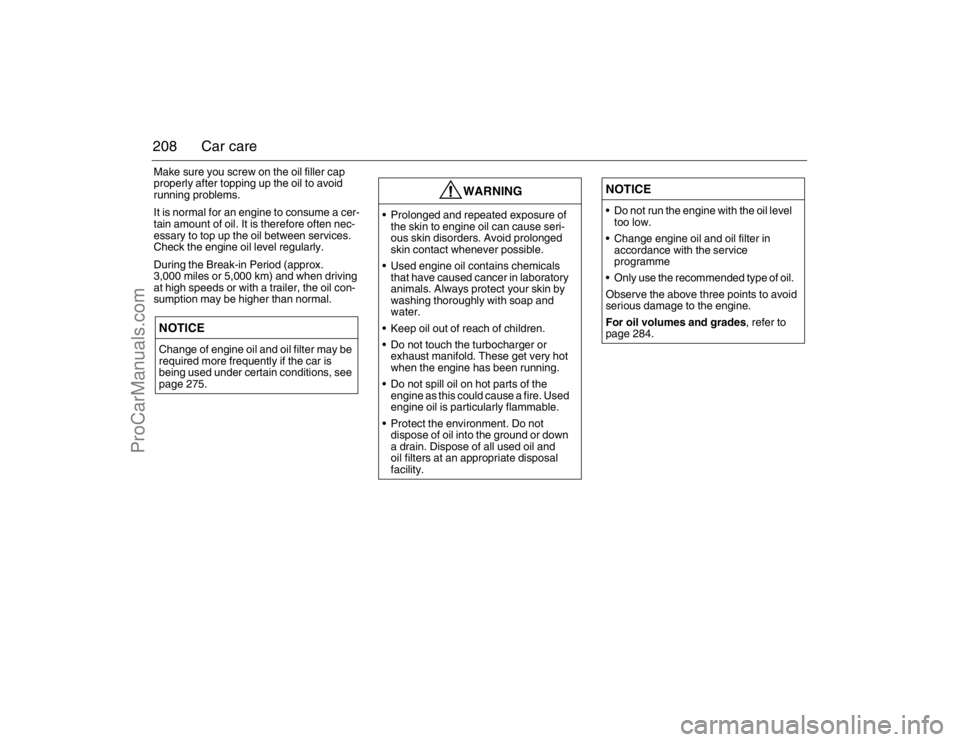
208 Car careMake sure you screw on the oil filler cap
properly after topping up the oil to avoid
running problems.
It is normal for an engine to consume a cer-
tain amount of oil. It is therefore often nec-
essary to top up the oil between services.
Check the engine oil level regularly.
During the Break-in Period (approx.
3,000 miles or 5,000 km) and when driving
at high speeds or with a trailer, the oil con-
sumption may be higher than normal.NOTICEChange of engine oil and oil filter may be
required more frequently if the car is
being used under certain conditions, see
page 275.
WARNING
Prolonged and repeated exposure of
the skin to engine oil can cause seri-
ous skin disorders. Avoid prolonged
skin contact whenever possible.
Used engine oil contains chemicals
that have caused cancer in laboratory
animals. Always protect your skin by
washing thoroughly with soap and
water.
Keep oil out of reach of children.
Do not touch the turbocharger or
exhaust manifold. These get very hot
when the engine has been running.
Do not spill oil on hot parts of the
engine as this could cause a fire. Used
engine oil is particularly flammable.
Protect the environment. Do not
dispose of oil into the ground or down
a drain. Dispose of all used oil and
oil filters at an appropriate disposal
facility.
NOTICE Do not run the engine with the oil level
too low.
Change engine oil and oil filter in
accordance with the service
programme
Only use the recommended type of oil.
Observe the above three points to avoid
serious damage to the engine.
For oil volumes and grades, refer to
page 284.
93_U S _M 07.book Page 208 W ednesday, April 12, 2006 9:30 AM
ProCarManuals.com
Page 209 of 304
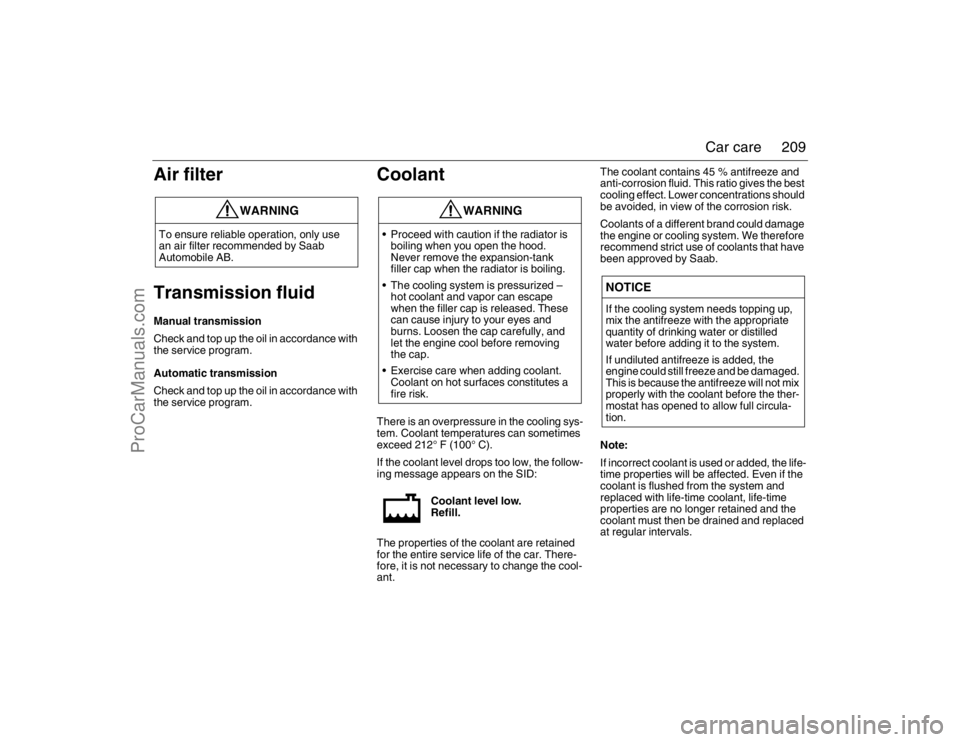
209 Car care
Air filter
Transmission fluidManual transmission
Check and top up the oil in accordance with
the service program.
Automatic transmission
Check and top up the oil in accordance with
the service program.
CoolantThere is an overpressure in the cooling sys-
tem. Coolant temperatures can sometimes
exceed 212° F (100° C).
If the coolant level drops too low, the follow-
ing message appears on the SID:
The properties of the coolant are retained
for the entire service life of the car. There-
fore, it is not necessary to change the cool-
ant.The coolant contains 45 % antifreeze and
anti-corrosion fluid. This ratio gives the best
cooling effect. Lower concentrations should
be avoided, in view of the corrosion risk.
Coolants of a different brand could damage
the engine or cooling system. We therefore
recommend strict use of coolants that have
been approved by Saab.
Note:
If incorrect coolant is used or added, the life-
time properties will be affected. Even if the
coolant is flushed from the system and
replaced with life-time coolant, life-time
properties are no longer retained and the
coolant must then be drained and replaced
at regular intervals.
WARNING
To ensure reliable operation, only use
an air filter recommended by Saab
Automobile AB.
WARNING
Proceed with caution if the radiator is
boiling when you open the hood.
Never remove the expansion-tank
filler cap when the radiator is boiling.
The cooling system is pressurized –
hot coolant and vapor can escape
when the filler cap is released. These
can cause injury to your eyes and
burns. Loosen the cap carefully, and
let the engine cool before removing
the cap.
Exercise care when adding coolant.
Coolant on hot surfaces constitutes a
fire risk.
Coolant level low.
Refill.
NOTICEIf the cooling system needs topping up,
mix the antifreeze with the appropriate
quantity of drinking water or distilled
water before adding it to the system.
If undiluted antifreeze is added, the
engine could still freeze and be damaged.
This is because the antifreeze will not mix
properly with the coolant before the ther-
mostat has opened to allow full circula-
tion.
93_U S _M 07.book Page 209 W ednesday, April 12, 2006 9:30 AM
ProCarManuals.com
Page 210 of 304
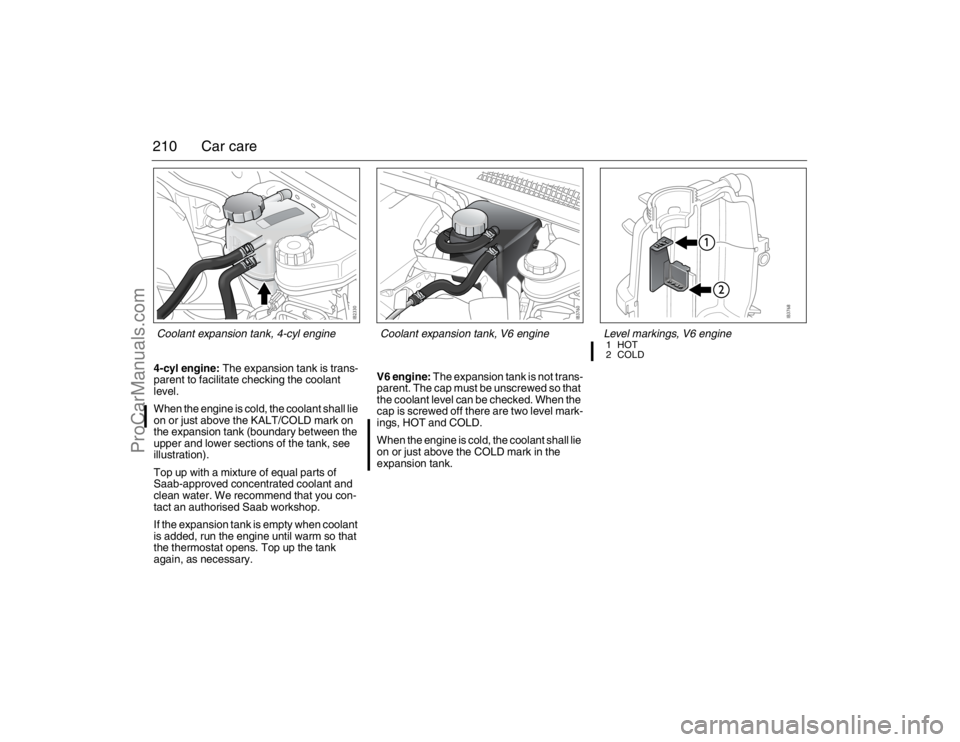
210 Car care4-cyl engine: The expansion tank is trans-
parent to facilitate checking the coolant
level.
When the engine is cold, the coolant shall lie
on or just above the KALT/COLD mark on
the expansion tank (boundary between the
upper and lower sections of the tank, see
illustration).
Top up with a mixture of equal parts of
Saab-approved concentrated coolant and
clean water. We recommend that you con-
tact an authorised Saab workshop.
If the expansion tank is empty when coolant
is added, run the engine until warm so that
the thermostat opens. Top up the tank
again, as necessary.V6 engine: The expansion tank is not trans-
parent. The cap must be unscrewed so that
the coolant level can be checked. When the
cap is screwed off there are two level mark-
ings, HOT and COLD.
When the engine is cold, the coolant shall lie
on or just above the COLD mark in the
expansion tank.
Coolant expansion tank, V6 engine Level markings, V6 engine
1HOT
2COLD
Coolant expansion tank, 4-cyl engine93_U S _M 07.book Page 210 W ednesday, April 12, 2006 9:30 AM
ProCarManuals.com
Page 212 of 304
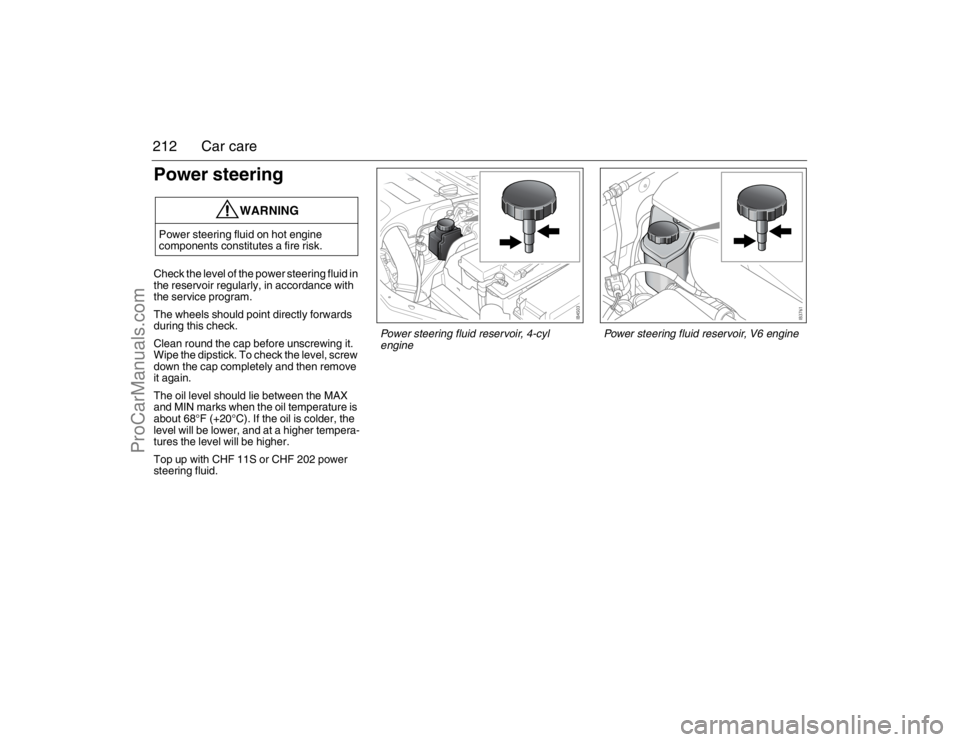
212 Car carePower steeringCheck the level of the power steering fluid in
the reservoir regularly, in accordance with
the service program.
The wheels should point directly forwards
during this check.
Clean round the cap before unscrewing it.
Wipe the dipstick. To check the level, screw
down the cap completely and then remove
it again.
The oil level should lie between the MAX
and MIN marks when the oil temperature is
about 68°F (+20°C). If the oil is colder, the
level will be lower, and at a higher tempera-
tures the level will be higher.
Top up with CHF 11S or CHF 202 power
steering fluid.
WARNING
Power steering fluid on hot engine
components constitutes a fire risk.
Power steering fluid reservoir, 4-cyl
engine
Power steering fluid reservoir, V6 engine
93_U S _M 07.book Page 212 W ednesday, April 12, 2006 9:30 AM
ProCarManuals.com
Page 213 of 304
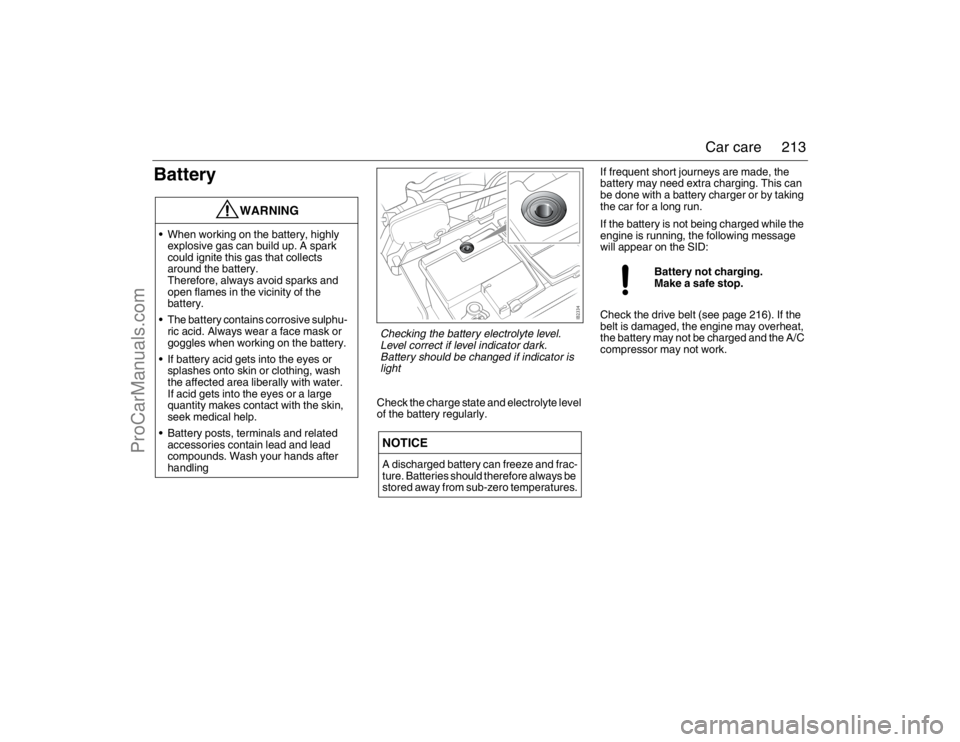
213 Car care
Battery
Check the charge state and electrolyte level
of the battery regularly.If frequent short journeys are made, the
battery may need extra charging. This can
be done with a battery charger or by taking
the car for a long run.
If the battery is not being charged while the
engine is running, the following message
will appear on the SID:
Check the drive belt (see page 216). If the
belt is damaged, the engine may overheat,
the battery may not be charged and the A/C
compressor may not work.
WARNING
When working on the battery, highly
explosive gas can build up. A spark
could ignite this gas that collects
around the battery.
Therefore, always avoid sparks and
open flames in the vicinity of the
battery.
The battery contains corrosive sulphu-
ric acid. Always wear a face mask or
goggles when working on the battery.
If battery acid gets into the eyes or
splashes onto skin or clothing, wash
the affected area liberally with water.
If acid gets into the eyes or a large
quantity makes contact with the skin,
seek medical help.
Battery posts, terminals and related
accessories contain lead and lead
compounds. Wash your hands after
handling
NOTICEA discharged battery can freeze and frac-
ture. Batteries should therefore always be
stored away from sub-zero temperatures.
Battery not charging.
Make a safe stop.
Checking the battery electrolyte level.
Level correct if level indicator dark.
Battery should be changed if indicator is
light
93_U S _M 07.book Page 213 W ednesday, April 12, 2006 9:30 AM
ProCarManuals.com
Page 219 of 304
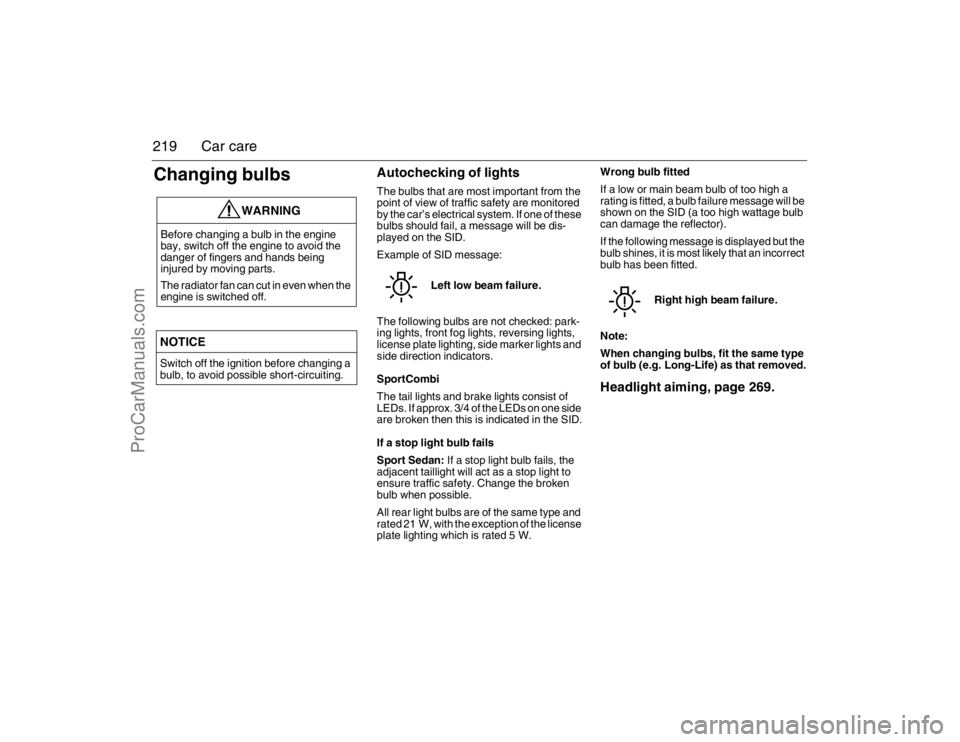
219 Car careChanging bulbs
Autochecking of lightsThe bulbs that are most important from the
point of view of traffic safety are monitored
by the car’s electrical system. If one of these
bulbs should fail, a message will be dis-
played on the SID.
Example of SID message:
The following bulbs are not checked: park-
ing lights, front fog lights, reversing lights,
license plate lighting, side marker lights and
side direction indicators.
SportCombi
The tail lights and brake lights consist of
LEDs. If approx. 3/4 of the LEDs on one side
are broken then this is indicated in the SID.
If a stop light bulb fails
Sport Sedan: If a stop light bulb fails, the
adjacent taillight will act as a stop light to
ensure traffic safety. Change the broken
bulb when possible.
All rear light bulbs are of the same type and
rated 21 W, with the exception of the license
plate lighting which is rated 5 W.Wrong bulb fitted
If a low or main beam bulb of too high a
rating is fitted, a bulb failure message will be
shown on the SID (a too high wattage bulb
can damage the reflector).
If the following message is displayed but the
bulb shines, it is most likely that an incorrect
bulb has been fitted.
Note:
When changing bulbs, fit the same type
of bulb (e.g. Long-Life) as that removed.
Headlight aiming, page 269.
WARNING
Before changing a bulb in the engine
bay, switch off the engine to avoid the
danger of fingers and hands being
injured by moving parts.
The radiator fan can cut in even when the
engine is switched off.NOTICESwitch off the ignition before changing a
bulb, to avoid possible short-circuiting.
Left low beam failure.
Right high beam failure.
93_U S _M 07.book Page 219 W ednesday, April 12, 2006 9:30 AM
ProCarManuals.com
Page 234 of 304
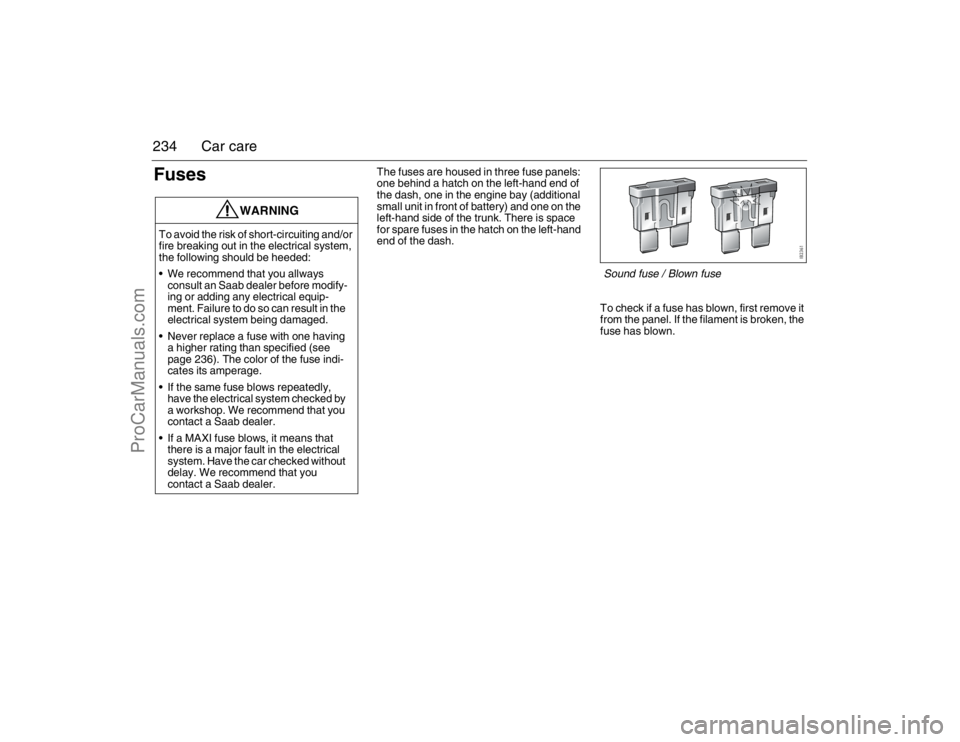
234 Car careFuses
The fuses are housed in three fuse panels:
one behind a hatch on the left-hand end of
the dash, one in the engine bay (additional
small unit in front of battery) and one on the
left-hand side of the trunk. There is space
for spare fuses in the hatch on the left-hand
end of the dash.
To check if a fuse has blown, first remove it
from the panel. If the filament is broken, the
fuse has blown.
WARNING
To avoid the risk of short-circuiting and/or
fire breaking out in the electrical system,
the following should be heeded:
We recommend that you allways
consult an Saab dealer before modify-
ing or adding any electrical equip-
ment. Failure to do so can result in the
electrical system being damaged.
Never replace a fuse with one having
a higher rating than specified (see
page 236). The color of the fuse indi-
cates its amperage.
If the same fuse blows repeatedly,
have the electrical system checked by
a workshop. We recommend that you
contact a Saab dealer.
If a MAXI fuse blows, it means that
there is a major fault in the electrical
system. Have the car checked without
delay. We recommend that you
contact a Saab dealer.
Sound fuse / Blown fuse
93_U S _M 07.book Page 234 W ednesday, April 12, 2006 9:30 AM
ProCarManuals.com